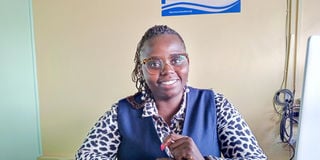One woman, six children, and the Nessuit clashes that changed everything

Nkatha Mugao poses for a photo after an interview with Mtaa Wangu on 19th May 2025.
In 2013, Flora Nkatha Mugao was working in the finance sector and was transferred from Nairobi to Nakuru. Like many before her, she came with dreams, a steady job, and a side hustle selling mitumba clothes. Life was stable.
She had no idea that within a few years, her life would take a turn, not for herself, but for the sake of others.
In 2017, during the tragic Nessuit clashes, everything changed. She had just been promoted at her job, and with a small car at her disposal, she chose not to stand by.
Instead, she turned her car into a rescue vehicle, hiring a driver to help transport the wounded to hospitals. That’s when she met the first six children—malnourished, abandoned, and fragile. One was hospitalized for three months. The other five had no place to go.
“I thought I could take two and find others to take in the rest. But the children's department had other plans—siblings must stay together. With no other options, I took them all in,” she recalls
For six months, she became their guardian. She hired a house help, bought special foods, facilitated medical assessments, and kept detailed progress reports. It wasn’t her plan. But purpose rarely asks for permission—it just pulls at your soul until you answer.
By 2019, she had found a more sustainable path—partnering with a children’s home like Salama Malaika in Njoro, to take in the kids she could no longer house.
“I knew it was not sustainable to raise children until they were 18, and I needed to help them find stability, and if not, find alternatives.”
This experience sparked something deeper. A friend connected her to UNICEF, which led to a crucial realization: real help often only comes when you are part of an organization.

Some of the awards Nkatha Mugao has received because of her work.
"Since I was working as an individual, I needed to have an organization to be able to get the much-needed support, so I founded the Frolics of Hope Africa Organization, with dreams of turning compassion into structured support," she says.
She highlights that the journey wasn’t easy since the organization couldn’t receive funding until it was at least five years old.
This, she says, led to doubts creeping in—both from within and around her, where some people misunderstood her intentions.
That clarity shaped the creation of a rescue center, different from a traditional children’s home.
“With a children's home, once you hit capacity, that's it. But with a rescue center, we can transition people and make space for those in urgent need. The rescue center helped us to be able to serve more victims of abuse, trafficking, exploitation, FGM, and early marriage," she says.
To date, the center has 12 full-time staff and has empowered over 7,200 volunteers across the country who support fieldwork and provide critical information.
She notes that her biggest reward is seeing a broken child transform, smiling, laughing, and finally ready to return to the community after therapy and care.
Her efforts haven’t gone unnoticed. She’s received multiple awards, but the Mashujaa Award stands out since it is a recognition signed internationally that validates her calling.
“In five years, I hope we’ll have a permanent space, not just a rented space for the rescue center, and have a fully-fledged rescue center, open to the public, with capacity to serve on a national scale,” Nkatha highlights
She notes that running a rescue center, people often assume children only need food or clothes. But the work runs deeper: therapy, medical care, education, and most importantly, love.
And when the weight becomes too much? She returns to the center.
“Every time I walk in, the first to run and hug me are those kids. And in that moment, I remember exactly why I started. I can’t walk away,” she says.
For Nkatha, what began as a single act of compassion during a crisis evolved into a movement of healing and hope.
Through Frolics of Hope Africa, she has not only transformed the lives of vulnerable children but also reshaped how communities respond to crisis.


